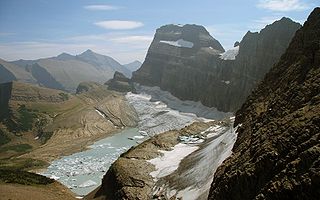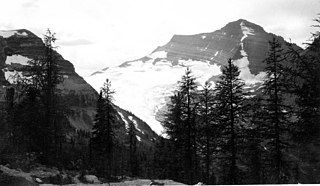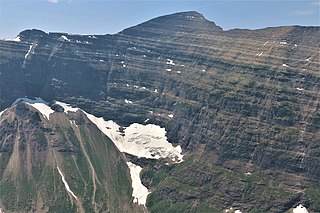
Grinnell Glacier is in the heart of Glacier National Park in the U.S. state of Montana. The glacier is named for George Bird Grinnell, an early American conservationist and explorer, who was also a strong advocate of ensuring the creation of Glacier National Park. The glacier is in the Lewis Range and rests on the north flank of Mount Gould at an altitude averaging 7,000 feet (2,100 m), in the Many Glacier region of the park.

Blackfoot Glacier is the second largest of the remaining 25 glaciers in Glacier National Park, Montana. Blackfoot Glacier is just to the north of Blackfoot Mountain and near Jackson Glacier. The glacier was most recently measured in 2015 at 370 acres (1.5 km2), yet when first documented in 1850, the glacier also included the now separate Jackson Glacier and together, they covered 1,875 acres (7.59 km2). In 1850, there were an estimated 150 glaciers in the park. Glaciologists have stated that by the year 2030, all the glaciers in the park may disappear. However, under a modest increase in overall carbon dioxide levels, some glaciers will remain until the late 23rd century.

Jackson Glacier is approximately the seventh largest of the remaining 25 glaciers in Glacier National Park located in the US state of Montana. A part of the largest grouping of glaciers in the park, Jackson Glacier rests on the north side of Mount Jackson. The glacier was most recently measured in 2005 at 250 acres (1.0 km2), yet when first documented in 1850, the glacier also included the now separate Blackfoot Glacier and together, they covered 1,875 acres (7.59 km2). Between 1966 and 2005, Jackson Glacier lost almost a third of its acreage. When the two mountains were united prior to their separation sometime before 1929, they were known simply as Blackfoot Glacier.

Schoolroom Glacier is a small glacier in Grand Teton National Park in the U.S. state of Wyoming. This Teton Range glacier lies adjacent to the south Cascade Canyon trail at an altitude of 10,400 ft (3,200 m), approximately 12 mi (19 km) from the trailhead at Jenny Lake. The glacier has many of the classic textbook details of a glacier, namely, well defined terminal and lateral moraines, crevasses, a proglacial lake and related features which led to the naming schoolroom.

Swiftcurrent Glacier is in Glacier National Park in the U.S. state of Montana.The glacier is on the east side of the Continental Divide arête known as the Garden Wall. Swiftcurrent Glacier is one of several glaciers that are being monitored to determine stream flow alterations that occur due to glacial retreat. Compared to other glaciers in Glacier National Park, Swiftcurrent Glacier has experienced relatively slow retreat. As of 2005, the glacier had an area of 55 acres (0.22 km2), a 14 percent reduction since 1966.

Stanton Glacier is a glacier in Flathead National Forest in the U.S. state of Montana. The glacier is situated in a cirque on the northeast slope of Great Northern Mountain. Stanton Glacier is one of several glaciers that have been selected for monitoring by the U.S. Geological Survey's Glacier Monitoring Research program, which is researching changes to the mass balance of glaciers in and surrounding Glacier National Park (U.S.). Stanton Glacier is 1 mile (1.6 km) northwest of Grant Glacier.

Grant Glacier is located in the US state of Montana in Flathead National Forest. The glacier is situated in a cirque and lies below the east slopes of Mount Grant. Grant Glacier is 1 mile (1.6 km) southeast of Stanton Glacier and both 5 miles (8.0 km) west of Glacier National Park (U.S.). Images taken of the glacier in 1902 and from the same vantage point in 1998 indicate that the glacier retreated substantially during the 20th Century.

Agassiz Glacier is in Glacier National Park in the U.S. state of Montana. It is named after Louis Agassiz, a Swiss-American glaciologist. The glacier is situated in a cirque to the southeast of Kintla Peak west of the Continental Divide. Agassiz Glacier is one of several glaciers that have been selected for monitoring by the U.S. Geological Survey's Glacier Monitoring Research program, which is researching changes to the mass balance of glaciers in and surrounding Glacier National Park.

Boulder Glacier is located in the U.S. state of Montana in Glacier National Park (U.S.). The glacier is situated to the north of Boulder Peak and west of the Continental Divide. Between 1966 and 2005, Boulder Glacier lost more than 75 percent of its surface area. As of 2005 the glacier was measured to cover only 13 acres (0.053 km2), and no longer met the 25 acres (0.10 km2) threshold often cited as the minimal area to qualify as an active glacier.

Shepard Glacier is a glacier remnant (glacieret) In Glacier National Park in the U.S. state of Montana. The glacieret is immediately southeast of Cathedral Peak. Shepard Glacier was one of a number of glaciers that have been documented by the United States Geological Service (USGS) to have retreated significantly in Glacier National Park. Shepard Glacier was measured in 2009 to have decreased to less than 25 acres (0.10 km2), considered to be a minimal size to qualify as being considered an active glacier. Between 1966 and 2005, Shepard Glacier lost 56 percent of its surface area.
Miche Wabun Glacier is a glacier remnant (glacieret) in the U.S. state of Montana in the northeastern region of Glacier National Park. The glacieret is situated in a cirque to the east of Goat Haunt Mountain. Miche Wabun Glacier was measured in 2010 to have retreated to less than 25 acres (0.10 km2) in area, considered to be a minimal size to qualify as being considered an active glacier. Between 1966 and 2005, the glacier lost over 55 percent of its surface area.

Logan Glacier is in Glacier National Park in the U.S. state of Montana. The glacier is situated in a cirque to the northeast of Mount Logan. Just east of the Continental Divide, Logan Glacier is northwest of Red Eagle Glacier. Estimated in 2005 to cover an area of 75 acres (0.30 km2), Logan Glacier covered almost 125 acres (0.51 km2) in 1966, a reduction in area of 40 percent in about 40 years. Comparing images of the glacier taken in 1914 with those from 2009, indicates that the glacier has experienced extensive retreat.

Red Eagle Glacier is a glacier remnant (glacieret) in Glacier National Park in the U.S. state of Montana. The glacieret is a hanging glacier located on the north slope of Clyde Peak, and to the southeast of Mount Logan and Logan Glacier. Between 1966 and 2005, Red Eagle Glacier lost 53 percent of its surface area and now covers less than 25 acres (0.10 km2) which is below the threshold to qualify as an active glacier. Comparing images of the glacier taken in 1914 with those from 2009, indicates that the glacier has experienced extensive retreat.

Harrison Glacier is a glacier located in the US state of Montana in Glacier National Park. Situated on a southeast‐facing ridge immediately south of Mount Jackson, it is the largest remaining glacier in Glacier National Park, estimated in 2005 to have an area of 466 acres (1.89 km2). Though many experts have stated that all the glaciers in Glacier National Park may disappear by the year 2030, Harrison Glacier lost only 9 percent of its surface area in the 40-year period between 1966 and 2005 and will likely still exist well beyond 2030. Compared to many of the vanishing glaciers in Glacier National Park, Harrison Glacier's accumulation zone is at a much higher altitude, which has allowed it to maintain some equilibrium in its glacier mass balance. Comparisons of images of the glacier taken in 1913 with images from 2009 indicate that the glacier has experienced thinning and retreat.
Dixon Glacier is located in the U.S. state of Montana in Glacier National Park. The glacier is situated in a cirque immediately to the north of The Sentinel at an elevation between 8,500 feet (2,600 m) and 7,400 feet (2,300 m) above sea level. Immediately east of the Continental Divide, the glacier is 1 mi (1.6 km) east of Thunderbird Glacier. Dixon Glacier covers an area of approximately 59 acres (0.24 km2) and between 1966 and 2005 lost over 45 percent of its surface area.
Ipasha Glacier is located in the US state of Montana in Glacier National Park. The glacier is situated in a cirque to the southeast of Chaney Glacier and immediately east of the Continental Divide at an elevation between 8,000 feet (2,400 m) and 7,600 feet (2,300 m) above sea level. The glacier covers an area of approximately 52 acres (0.21 km2) as measured in 2005, which is a third smaller than it was in 1966. Melt water from the glacier flows over Ipasha Falls en route to Ipasha Lake.

Lupfer Glacier is in Glacier National Park in the U.S. state of Montana. The glacier is situated immediately to the east of Mount Phillips at an elevation between 6,500 ft (2,000 m) and 6,000 ft (1,800 m) above sea level. Lupfer Glacier covers an area of approximately 16 acres (0.065 km2) and does not meet the threshold of 25 acres (0.10 km2) often cited as being the minimum size to qualify as an active glacier. Between 1966 and 2005 Lupfer Glacier lost over 50 percent of its surface area.

Piegan Glacier is in Glacier National Park in the U.S. state of Montana. The glacier is situated in a cirque on the southeast slope of Piegan Mountain and just below the summit at an elevation between 8,800 and 8,200 ft above sea level. The glacier covered an area of approximately 62 acres (0.25 km2) in 2005, a 10 percent reduction in its surface area since 1966. Comparing images of the glacier taken in 1930 with those from 1998, indicates that the glacier experienced relatively little change during that period.

Pumpelly Glacier is in Glacier National Park in the U.S. state of Montana. The glacier is situated immediately northeast of Blackfoot Mountain at an elevation between 8,500 and 8,000 ft above sea level. Pumpelly Glacier is just west of the Continental Divide and adjacent to Pumpkin Glacier, the two glaciers separated by crevasses. The glacier was named after Raphael Pumpelly who had first sighted the glacier in 1883. Pumpelly and Pumpkin Glaciers cover 310 acres (1.3 km2) as of 2005, a 15 percent reduction in area since 1966.

The Salamander Glacier is in Glacier National Park in the U.S. state of Montana. The glacier lies on a shelf on the east side of the arête which is part of the Continental Divide, at an average elevation of 7,200 feet (2,200 m) above sea level. The Salamander Glacier covered an area of approximately 57 acres (0.23 km2) as of 1993. Before Grinnell Glacier retreated significantly, it used to encompass The Salamander Glacier and the two become separate sometime before 1929. The Salamander Glacier was measured at 42 acres (0.17 km2) in 2005, which is a 23 percent reduction since 1966. Though only .10 mi (0.16 km) in length, The Salamander Glacier is about .75 mi (1.21 km) wide.



















